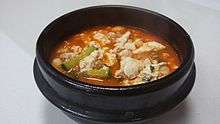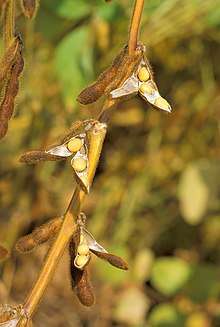Sundubu-jjigae
 | |
| Alternative names | Soft tofu stew |
|---|---|
| Type | Jjigae |
| Place of origin | Korea |
| Main ingredients | Sundubu (extra soft tofu) |
| Korean name | |
| Hangul | 순두부찌개 |
|---|---|
| Hanja | -豆腐-- |
| Revised Romanization | sundubu-jjigae |
| McCune–Reischauer | sundubu-tchigae |
| IPA | [sun.du.bu.t͈ɕi.ɡɛ̝] |
Sundubu-jjigae[1] (순두부찌개) or soft tofu stew[1] is a jjigae (Korean stew) in Korean cuisine. The dish is made with freshly curdled soft tofu (which has not been strained and pressed), vegetables, sometimes mushrooms, onion, optional seafood (commonly oysters, mussels, clams and shrimp), optional meat (commonly beef or pork), and gochujang (chili paste) or gochu garu (chili powder). The dish is assembled and cooked directly in the serving vessel, which is traditionally made of thick, robust porcelain, but can also be ground out of solid stone. A raw egg can be put in the jjigae just before serving, and the dish is delivered while bubbling vigorously. It is typically eaten with a bowl of cooked white rice and several banchan (side dishes).[2]
Extra soft tofu, called sundubu (순두부; "mild tofu") in Korean, is softer than other types of tofu and is usually sold in tubes. Although sun in sundubu doesn't have Sino-Korean origin,[3] sundubu is often translated into Chinese and Japanese using the Chinese character 純, whose Korean pronunciation is sun and the meaning is "pure". Thus in China, sundubu is called chún dòufu (純豆腐; "pure tofu"), and in Japan, it is called jun tōfu (純豆腐) or sundubu (スンドゥブ).
History
The origins of using unpressed tofu in Korean cuisine is not well documented, but records from the Joseon dynasty archives show an early form of sundubu jjigae being served. Some historians assume that unpressed tofu use spread to the masses during the Joseon dynasty.[4]
Overseas
In the 1990s, Korean immigrants in Los Angeles brought sundubu jjigae to the United States.[5][6] Hee Sook Lee, a first-generation Korean immigrant, opened the first sundubu restaurant in the Koreatown neighborhood of Los Angeles.[5]
See also
References
- 1 2 (in Korean) "주요 한식명(200개) 로마자 표기 및 번역(영, 중, 일) 표준안" [Standardized Romanizations and Translations (English, Chinese, and Japanese) of (200) Major Korean Dishes] (PDF). National Institute of Korean Language. 2014-07-30. Retrieved 2017-02-19. Lay summary.
- ↑ 순두부찌개 (in Korean). EncyKorea. Retrieved 2015-05-01.
- ↑ (in Korean) "순-두부 (-豆腐)". Standard Korean Language Dictionary. National Institute of Korean Language. Retrieved 2017-02-26.
- ↑ 순두부찌개 (in Korean). Korea Food Research Institute. Retrieved 2015-05-01.
- 1 2 Kim, Victoria (January 24, 2008). "Korean immigrant reigns over an empire of tofu stew". Los Angeles Times. Retrieved 2015-05-01.
- ↑ A conversation with Roy Choi (YouTube). University of Southern California Korean Studies Institute. April 26, 2012. Event occurs at 7 minutes 20 seconds.
External links
| Wikimedia Commons has media related to Sundubu jjigae. |
